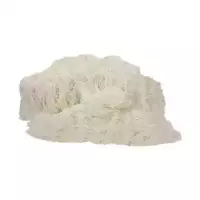Kadaif dough

Most likely, almost everyone who has come to Turkey or another country in the East has tried or seen a huge number of sweets that are made from the thinnest threads of dough. Moreover, these are just baked threads poured with syrup, and twisted or rolled threads with a filling - nuts, cheese or cream. In addition, "squares, " "sausages, " "nests, " "shells, " generously watered with syrup and possibly sprinkled with various kinds of delicious components - all this is made of kadaif dough.
It is noteworthy that some types of oriental sweets based on this dough are called kadaif. Kadaif dough itself is quite fresh in taste - the sweetness of the final product is determined by the quality and amount of syrup used, as well as filling-sprinkles. Most of all, cadaif dough resembles our web vermicelli, although the latter is much thicker. Every time you look at this wonderful product, it is difficult to understand how the Turks manage to make it so subtle.
At the same time, the length of its threads, which can reach not only 1-2 meters, but also all 5, is considered a distinctive feature of the kadaifa dough. True, this applies to freshly prepared dough - as a rule, a product that can be purchased in specialized stores is pre-cut.
Basically, lovers of oriental sweets buy industrial-made cadaif dough, as it is extremely difficult to make it at home. By the way, the point here is not even in expensive products, but in the lack of the necessary skill and place for its manufacture. In general, cadaif dough is both manual and machine, but this is practically never indicated on the package.
The composition of the cadaif test itself is quite simple. First of all, on the basis of sifted flour and water, a rather thick dough is kneaded, which is left for several hours under a lid or cling film. After the dough has rested, water is gradually added to it, bringing to the necessary liquid consistency, and again left to reach.
At the next stage of preparation of cadaif dough, a copper circle is evenly heated on the oven, the diameter of which is about one and a half meters. Liquid dough is poured into a special straining device called kyf and thin threads are evenly poured out of it onto the spinning surface.
In a few seconds, the dough dries, after which the finished threads of cadaif dough are collected in the desired order. In this case, the procedure is repeated until the dough is completely over. The finished cadaif dough is dried and packed, and then either goes into sale, or is used immediately for its intended purpose.
test cadaif 234.1 kCal
Energy value of the kadaif test (Ratio of proteins, fats, carbohydrates - ju):
Proteins: 7.9 g (~ 32 kCal)
Fats: 1.4 g (~ 13 kCal)
Carbohydrates: 50.6 g (~ 202 kCal)
Energy ratio (b | y): 13% | 5% | 86%
 Español
Español Français
Français Português
Português Русский
Русский 简体中文
简体中文 繁體中文
繁體中文 日本語
日本語 한국어
한국어 العربية
العربية Türkçe
Türkçe Қазақ
Қазақ Deutsch
Deutsch Italiano
Italiano Українська
Українська
